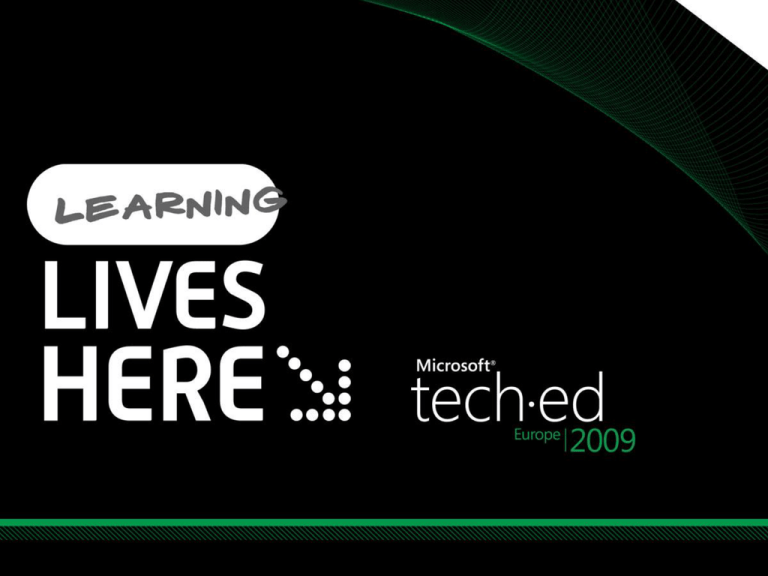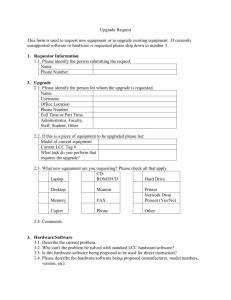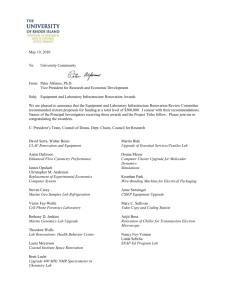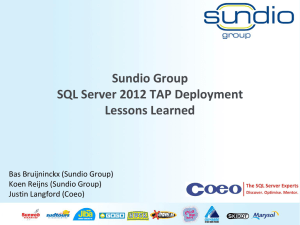
Dandy Weyn
Technical Development Manager
Microsoft
Session Code: DAT308
Your key to success …
Understanding Upgrade Strategies
Plan for Upgrade
Perform the Upgrade
Post-Upgrade
Upgrade Path Considerations
SQL SERVER VERSIONS
2000 SP4+
2005 SP2 +
COMPONENTS
DB Engine
RS
NS *
AS
DTS
IS
Developer
Enterprise
EDITIONS
Desktop
Workgroup
Personal
Standard
PLATFORMS
32-bit
64-bit (IA64 and x64)
LANGUAGES
All 2000
All 2005
In Place Upgrade
Pros
Easier, mostly automated,
generally fast overall process
System data upgraded
May require no additional
hardware
Applications remain pointing to
same server/DB
Cons
Less granular control over upgrade
process – all or nothing
Instance remains offline during part of
upgrade
Not best practice for all components
Rollback Strategy
SQLSQL
Server
2008
Server
Instance
2000/5
Instance
Upgrade
Upgrade Process
Point of no
return
Instance is still
available
Install
prerequisites
Check for
upgrade
blockers
Install SQL
Server 2008
binaries
Stop
service
Redirect
services to
new binaries
Start service in
single-user
mode
Instance is no
longer available
Attach
resource
database
Stop
service
Restart
service
Execute various
upgrade scripts
Start
updating all
databases
Partial
availability
starts here
Remove
old
binaries
Instance
becomes
available
Side by Side
SQL Server 200x
Instance
SQL Server 2008
Instance
Compare
and
Verify
Verified!
Install new instance of SQL Server
Transfer using:
Copy Database Wizard
Detach -> Copy -> Attach
Backup -> Restore
T-SQL Scripts, BCP , Break SAN
mirror -> attach
Upgrade Options
Side-by-Side
Pros
More granular control over upgrade process at DB level
Can be used to perform test migration
Ability to run systems side-by-side for parallel runs
Relatively straightforward rollback strategy
Cons
Usually require additional hardware
Server/database name changes
Not practical for VLDB unless utilizing SAN (hybrid approach)
Pre-Upgrade Considerations
Document existing SQL Server solution
sp_configure
SQLDIAG.EXE
sp_dboption
Configurations: SAN, networks, and security
Capture performance baseline data
System level (WMI, Counters, etc.)
Application level (query response, concurrent users, etc.)
Develop criteria and unit / verification tests
Optional: capture plans for complex queries
Deciding on Upgrade Strategy
Upgrade In-Place or Side-by-Side
Database size and number of objects
Local maintenance jobs
Tolerance for downtime
Hardware capacity / age
System dependencies & other applications
Back-out time
Pre-Upgrade Tasks: Backward Compatibility
Some features are discontinued:
They do not appear in SQL Server 2008
Examples
Undocumented system stored procedures
Virtual cube
Virtual dimension
DUMP / LOAD database
Backup with TRUNCATE ONLY
Some are deprecated:
They won’t be supported in a future SQL Server release (e.g.
Notification Services)
Some Known Compatibility Issues
Applications work fine on 8.0/9.0 compatibility
mode but fails in 10.0 mode
Additional ANSI SQL standards enforcements in 2008
(e.g. left and right outer joins using *= and =* no longer supported)
Modify SQL statements to be standards
compliant (will still work if in 8.0
compatibility mode)
Some Known Compatibility Issues
References to system and/or undocumented objects
Accessing system tables/stored procedures or undocumented
features may/will fail or behave differently
Utilize Dynamic Management Views and Functions
e.g. syslocks sys.dm_tran_locks
Undocumented objects are not supported, ever
Some Known Compatibility Issues
Poorer performance after upgrade
Review or remove
query hints
Do full updated
statistics
Queries take
longer to run
after upgrading to
SQL Server 2008
Review TempDB
utilization
Run DB Tuning
Advisor
Seek Customer
Support for
excessive issues
Use different
sampling size for
large tables
Optimize via
storage isolation
Some Known Compatibility Issues
Cannot access SQL Server after upgrade
Clients can no
longer connect
to the
database
server or
related
components
Check
Configuration
Manager
settings
“off-bydefault” is in
place for
features and
access
methods
Surface Area
Configuration
Manager
removed
Upgrade Advisor
17
Pre-Upgrade Tasks: Outside Forces
Database Solutions
COM Components
Extended Stored Procedures
sp_OA%
CLR assemblies
Linked Servers
Cross-database dependencies
DTS packages
Pre-Upgrade Tasks: Outside Forces
Some editions have a different feature set
Example: Express does not have SQL Server Agent
No substitute for knowing your application!
Especially if supporting international versions
Post-Upgrade Tasks
Immediate Tasks
Decision whether to roll back
Ensure performance
Resource Planning
Short-Term
Medium-Term
Long-Term
Immediate Post-Upgrade Tasks
Review all logs
Revisit Upgrade Advisor recommendations
Update statistics to ensure performance
Full if possible
Sample for very large tables
Reconfigure Log Shipping (if upgraded from 2000)
Immediate Post-Upgrade Tasks
Re-populate Full-Text catalogs
Verify Agent jobs and maintenance tasks
Verify security settings
Especially cross server and/or cross-domain access
privileges
Check database consistency
DBCC CHECKDB
DBCC UPDATEUSAGE (for 2000 upgrades)
Immediate Post Upgrade Tasks
Configuration Manager
Critical for Side-By-Side to reset environment, protocols,
etc…
Upgrade process “tries” to preserve functionality for InPlace
Size and configure tempdb correctly
DBCC CHECKDB, CTEs, Cursors, MARS, Row Versioning,
Service Broker, Triggers
Verify MODEL database
Verify MASTER database
Perform unit / verification tests
Commit upgrade or rollback!
Short-Term Post Upgrade Tasks
Data Types
Take advantage of new data types
From 2000: NVARCHAR(MAX), VARCHAR(MAX), VARBINARY(MAX), XML
From 2000/2005: Filestream, spatial, date, time, hierarchyID
Persisted columns
Index persisted columns
Database options
DB_CHAINING, EXECUTE AS
PAGE_VERIFY CHECKSUM
Evaluate AUTO_UPDATE_STATISTICS_ASYNC
Evaluate PARAMETERIZATION
Short-Term Post Upgrade Tasks
Partitioned Tables
Enterprise Edition
Partitioned Views -> Partitioned Tables
Appropriate lock escalation setting
Database Files / Filegroups
Performance Benefits
sp_configure ‘affinity mask’
sp_configure ‘affinity I/O mask’
Management Benefits
Reports, DMVs (including new and changed), etc.
Database Tuning Advisor
Medium-Term Post-Upgrade Tasks
Re-evaluate Optimizer Hints
Remove or document reasons to retain
Online operations
Enterprise Edition
Row Versioning
Evaluate Read Committed Snapshot Isolation (RCSI)
ALLOW_SNAPSHOT_ISOLATION
READ_COMMITTED_SNAPSHOT
Medium-Term Post-Upgrade Tasks
Re-evaluate Indexed Views
Definition of “determinism” has changed
Custom aggregations
Re-evaluate indexes
Optimizer has changed
Database Engine Tuning Advisor
Re-evaluate statistics
Sampling
Automatic
Manual
Long-Term Post-Upgrade Tasks
Re-write “COM components” as CLR
XPs to C# or VB in CLR
Custom CLR types in 2005
E.g. date, time, spatial
Deprecated Features
xp_sendmail / SQL Mail
Data types
Long-Term Post-Upgrade Tasks
DTS Packages
Especially if “upgrade” from 2000 to 2005 then
2008 without re-write
Security
Schemas
Different encryption options
New audit capabilities
There are many more!
Especially for 2000 upgrades – see Books Online
Dandy Weyn – dandyw@microsoft.com
Complete an evaluation
on CommNet and enter to
win an Xbox 360 Elite!
Related Content
SQL Server 2008 Upgrade Technical Reference
Hands-on-Labs: DAT23 – Upgrading from SQL2000/2005 to SQL Server 2008
Resources
www.microsoft.com/teched
www.microsoft.com/learning
Sessions On-Demand & Community
Microsoft Certification & Training Resources
http://microsoft.com/technet
http://microsoft.com/msdn
Resources for IT Professionals
Resources for Developers
© 2009 Microsoft Corporation. All rights reserved. Microsoft, Windows, Windows Vista and other product names are or may be registered trademarks and/or trademarks in the U.S. and/or other countries.
The information herein is for informational purposes only and represents the current view of Microsoft Corporation as of the date of this presentation. Because Microsoft must respond to changing market conditions, it should
not be interpreted to be a commitment on the part of Microsoft, and Microsoft cannot guarantee the accuracy of any information provided after the date of this presentation. MICROSOFT MAKES NO WARRANTIES, EXPRESS,
IMPLIED OR STATUTORY, AS TO THE INFORMATION IN THIS PRESENTATION.





